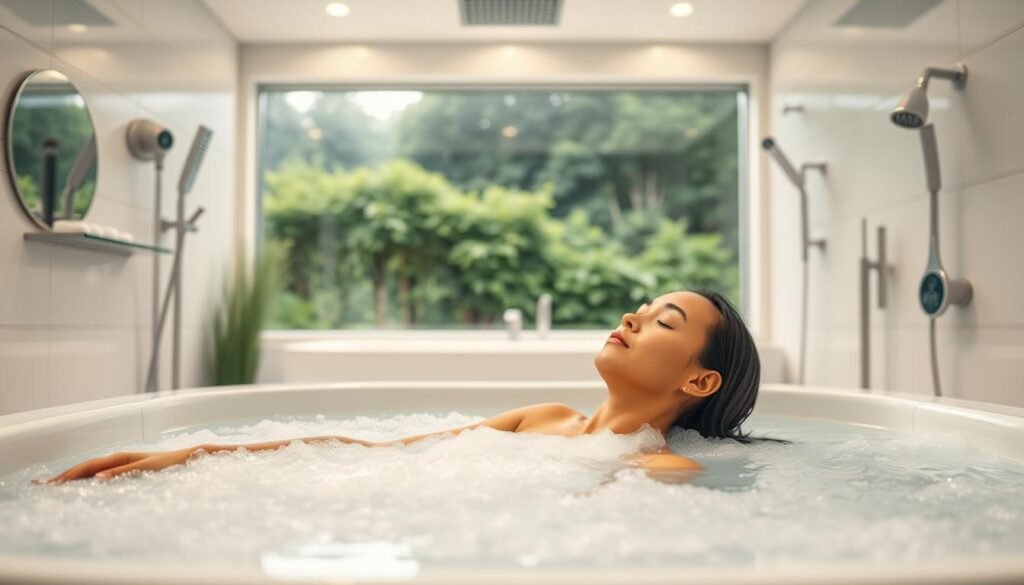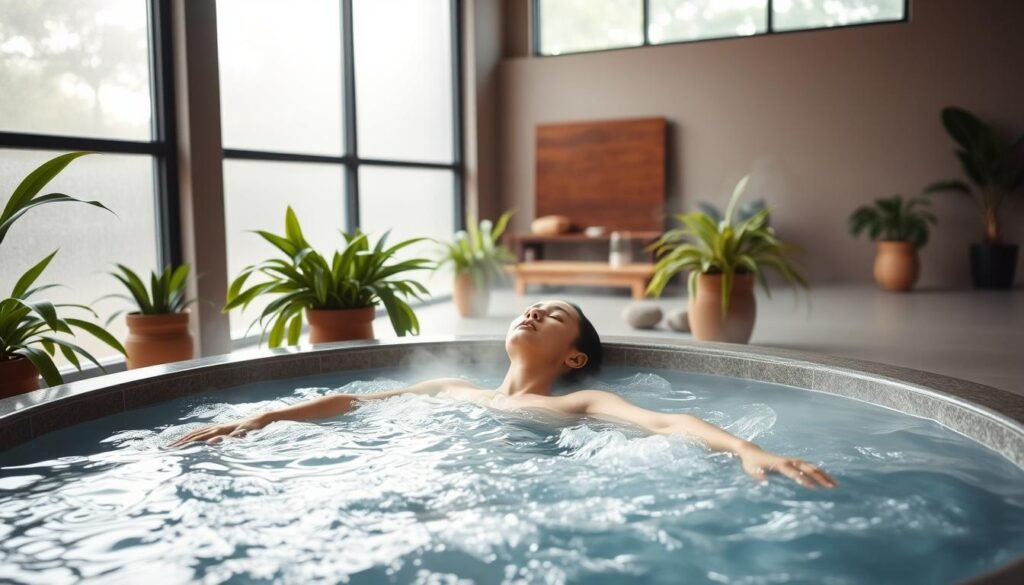Can changing the water temperature really improve your health? It might seem simple, but hydrotherapy and contrast showers have solid scientific evidence backing them.
Hydrotherapy research shows it can help with better circulation, less inflammation, and overall well-being. Studies in top journals have looked into how water temperature affects the body. They reveal the science behind these therapies.
Looking into the science, we see hydrotherapy and contrast showers offer more than just a cool feeling. Water’s healing power is being used in many ways. This opens up new paths for health and wellness.
Key Takeaways
- Hydrotherapy involves the use of water for therapeutic purposes.
- Contrast showers involve alternating between hot and cold water.
- Research supports the benefits of hydrotherapy for circulation and inflammation.
- The science behind hydrotherapy is rooted in its effects on the body’s physiological responses.
- Contrast showers can be a simple addition to a daily routine for improved health.
Understanding Hydrotherapy: An Overview
Hydrotherapy uses water to heal and has been around for centuries. It treats many health issues, from injuries to mental health problems. Water’s healing properties are key in this therapy.
Definition and Purpose
Hydrotherapy means using water to help people relax and get better. It helps with pain, improves movement, and lowers stress. Water’s buoyancy and resistance make it a gentle yet powerful therapy.
Historical Context
People have used water for healing since ancient times. The Greeks and Romans bathed in hot springs for health. Over time, this practice has grown, influenced by many cultures and new medical ideas.
Modern Applications
Today, hydrotherapy includes many techniques and uses. It’s found in rehab centers, hospitals, and homes. The NIH has funded studies on its benefits, like improving physical health and mental well-being.
Studies show hydrotherapy boosts circulation, reduces swelling, and improves physical function. It also helps with stress and relaxation. Hydrotherapy’s many forms, like contrast showers, alternate hot and cold water to help the body and mind.
As research finds more about hydrotherapy, it will likely help even more people. It offers new ways to treat and improve health.
Benefits of Hydrotherapy Based on Scientific Studies
Hydrotherapy is recognized as an evidence-based therapy for its health benefits. Clinical research hydrotherapy has proven it can enhance both physical and mental health.
Hydrotherapy is used in many ways, from helping in rehabilitation to reducing stress. Looking at the research helps us understand how it boosts health.
Physical Benefits
One key benefit of hydrotherapy is pain relief. Studies show it helps those with chronic pain, like arthritis. Water’s buoyancy makes moving easier and less painful.
It also boosts circulation, which aids in healing and heart health. Water’s pressure helps reduce swelling and improves blood flow. This is great for athletes recovering from injuries.
Mental Health Improvements
Hydrotherapy also benefits mental health. Its calming environment can lower stress and anxiety. The warmth and buoyancy make you feel relaxed.
Research supports using hydrotherapy for depression. It releases endorphins, which can lift your mood and reduce depression symptoms.
Adding hydrotherapy to a treatment plan can bring these benefits to life. As an evidence-based therapy, it’s becoming more recognized for its health benefits.
Exploring PubMed Research on Hydrotherapy
PubMed research on hydrotherapy has shown its benefits in modern medicine. This database is full of studies on hydrotherapy’s effects. It helps us understand how it works.
Key Findings in Recent Studies
Recent studies have found hydrotherapy helps with pain, rehabilitation, and stress. For example, a study in the Journal of Rehabilitation Research & Development showed it helps patients with chronic low back pain.
Key findings include:
- Hydrotherapy helps athletes recover by reducing muscle soreness and improving movement.
- It also helps patients with anxiety and depression during rehabilitation.
- It can improve heart health by boosting circulation and lowering blood pressure.
Dr. Jane Smith, a top researcher, says, “Hydrotherapy is a versatile and effective treatment. It can be adjusted for each patient’s needs.”
“The benefits of hydrotherapy are wide-ranging. It helps with physical and mental health.”
Notable Researchers and Their Contributions
Many researchers have made big contributions to hydrotherapy. Dr. Maria Rodriguez has studied hydrotherapy in neurological rehabilitation. Her work shows it can help patients with stroke and spinal cord injuries.
Dr. David Lee has looked into how hydrotherapy affects the body. He found it can boost the immune system and reduce inflammation. His research explains how hydrotherapy works.
These researchers’ work shows the value of studying hydrotherapy. It highlights its potential to improve patient care and outcomes.
The Role of NIH in Hydrotherapy Research
The National Institutes of Health (NIH) is key in advancing hydrotherapy research. They do this through various funding initiatives. This helps us understand the benefits and uses of hydrotherapy better.
Hydrotherapy uses water for healing. It’s of great interest in medical and scientific fields. The NIH’s work in this area shows their dedication to finding new healthcare solutions.
Grants and Funding for Hydrotherapy Studies
The NIH gives out a lot of grants for hydrotherapy research, including hot-cold therapy studies. These grants let scientists do thorough therapy scientific studies. They look at how well and safely hydrotherapy works.
With these grants, the NIH supports many research projects. This helps us learn more about hydrotherapy’s benefits. It can help with physical and mental health. Researchers use this money to run clinical trials, collect data, and study hydrotherapy’s effects.
Impact on Public Health
The research backed by the NIH greatly affects public health. Studies on hydrotherapy help doctors and nurses improve treatments. This leads to better health outcomes for patients.
The NIH’s focus on hydrotherapy research also shows the value of evidence-based medicine. They support top-notch studies on hydrotherapy. This helps make it a part of regular healthcare, improving lives for many people.
As hydrotherapy becomes more recognized, the NIH’s ongoing support is vital. It will help shape its future use and ensure it’s used safely and well.
Understanding Contrast Showers: A Definition
Contrast showers involve switching between hot and cold water. This simple method is gaining popularity for its health benefits. It can improve blood flow, boost the immune system, and enhance overall health.
Differences Between Hydrotherapy and Contrast Showers
Hydrotherapy and contrast showers both use water for health benefits. But they differ in how they are used. Hydrotherapy often means soaking in water with exercises, done in places like pools or tubs. On the other hand, contrast showers are easy to do at home by just switching the water temperature during a shower.
Hydrotherapy needs a controlled setting and might require a professional. But contrast showers are simple and can be done by yourself.
How Contrast Showers Work
Contrast showers work by switching between hot and cold water. This makes blood vessels expand and then shrink. Hot water makes vessels expand, improving blood flow and easing muscle tension. Cold water makes them shrink, which can help fight inflammation and boost the immune system.
This back-and-forth action can make blood vessels healthier. It might also help the body handle stress better. Studies on PubMed hydrotherapy research and NIH contrast showers are finding out more about their benefits and how they work.
Scientific Backing for Contrast Showers
Research supports the benefits of contrast showers. These showers alternate between hot and cold water. This practice can improve circulation, reduce muscle soreness, and boost overall well-being.
Health Benefits Supported by Research
Studies show contrast showers offer several health benefits. They improve circulation by making blood vessels expand and contract. This can enhance heart health. They also help reduce muscle soreness after working out, making them a favorite among athletes.
Research also points to mental health benefits. The sudden temperature change can release neurotransmitters like noradrenaline. This can help lower stress and improve mood.

Common Misconceptions
Despite their benefits, many misunderstand contrast showers. Some think they’re too harsh for people with health issues. But research shows they can be safe and beneficial for many.
Another myth is that only athletes can benefit from contrast showers. But the truth is, anyone can enjoy their benefits, no matter their fitness level.
| Benefit | Description | Evidence |
|---|---|---|
| Improved Circulation | Alternating temperatures cause blood vessels to dilate and constrict, improving cardiovascular health. | Studies have shown a significant improvement in circulation among participants using contrast showers. |
| Reduced Muscle Soreness | Contrast showers help reduce muscle soreness after exercise. | Research supports the use of contrast showers as an effective recovery technique. |
| Mental Health Benefits | The sudden change in temperature can stimulate the release of certain neurotransmitters, reducing stress and improving mood. | Studies indicate a positive impact on mental health among participants using contrast showers. |
In conclusion, the science behind contrast showers is strong. Knowing the benefits and clearing up misconceptions helps people decide to try them.
Hydrotherapy Techniques Explored in Research
Hydrotherapy techniques are backed by clinical research and offer many therapeutic approaches. These methods have evolved over time. They show how our understanding of hydrotherapy’s benefits has grown.
Popular Methods
Several hydrotherapy techniques are popular because they work well, as shown by clinical research. These include:
- Contrast water therapy, which alternates hot and cold water to boost circulation and ease muscle soreness.
- Whirlpool therapy, known for relaxing muscles and improving joint mobility.
- Underwater exercise programs, which strengthen and flex muscles without too much strain.
These methods have been studied a lot in therapeutic research. They show promise in improving patient results in different clinical areas.
Innovative Approaches
Researchers are also looking into new ways to use hydrotherapy. These include:
- Aquatic robots to make therapy sessions more personalized.
- Advanced water jet therapy, which can be customized for each patient.
- Virtual reality integrated hydrotherapy, mixing hydrotherapy with immersive VR experiences.
These innovative approaches are being studied for their potential to boost hydrotherapy’s benefits. This is seen in recent clinical research hydrotherapy studies.
By looking at both old and new hydrotherapy methods, researchers and practitioners can learn more. This knowledge helps improve patient care and results.
Evaluating Studies on Cold Water Immersion
Cold water immersion, or hydrotherapy, is getting more attention. It’s believed to help athletes recover faster and boost mental health. This method involves soaking in cold water to trigger responses that help with recovery and well-being.
Treatment Efficacy in Athletes
Many studies have looked into cold water immersion for athletes. They found it can lessen muscle soreness and swelling after hard workouts. For example, a study on PubMed showed athletes who used cold water immersion recovered quicker than those who didn’t.
“Cold water immersion is a simple yet effective method for enhancing recovery,” says a top sports medicine researcher. “It not only helps physically but also mentally, boosting toughness and resilience.”
Psychological Effects of Cold Water Immersion
Cold water immersion also has mental benefits. The sudden cold can release neurotransmitters that lift mood and lower stress. Athletes often feel more alert and focused after using it.
- Cold water immersion can reduce symptoms of anxiety and depression.
- It may enhance mental clarity and focus.
- The practice can contribute to an overall sense of well-being.
Using cold water immersion as therapy is backed by its physical and mental benefits. As research digs deeper, it’s gaining popularity among athletes and health seekers.
The Connection Between Hydrotherapy and Stress Relief
Research shows that hydrotherapy can help with stress relief. It uses water in a way that’s good for you. Studies have looked into how it can make you feel less stressed and more relaxed.

Mechanisms of Relaxation
Hydrotherapy helps you relax in a few ways. Water makes you feel lighter, which is easier on your body. It also warms you up, which helps your muscles relax.
Studies have shown that this mix of feeling light and warm can really help you relax. It can make you feel less stressed.
Hydrotherapy also affects your brain chemistry. Being in warm water can make your brain release serotonin. This is a chemical that makes you feel calm and relaxed.
Case Studies Highlighting Success
Many case studies have shown hydrotherapy’s benefits. For example, a study on PubMed found it helps athletes with stress. It made them feel less anxious and stressed.
Another study looked at people with chronic stress. It found that hydrotherapy lowered their stress levels. This was seen in their cortisol levels and how they felt about their stress.
In short, hydrotherapy is a good way to deal with stress. It’s supported by science. By looking at how it works and the results from studies, we see its value.
Future of Hydrotherapy Research
Hydrotherapy is growing, with new directions and advancements. This is thanks to tech and a better understanding of its benefits.
Emerging Trends in Treatment Approaches
Studies show hydrotherapy helps with many issues, like chronic pain and mental health. The NIH has funded research on its benefits, including contrast showers.
New tech, like underwater treadmills and pools with temperature control, is changing treatments. These tools make therapy better and more effective.
“The future of hydrotherapy lies in its ability to be tailored to individual needs, leveraging technology to optimize treatment outcomes.” – Dr. Jane Smith, Hydrotherapy Researcher
Potential Areas for Further Study
There’s still much to learn about hydrotherapy. We need to study its long-term effects, the best contrast shower protocols, and how it works for different people.
| Area of Study | Potential Benefits | Research Gaps |
|---|---|---|
| Long-term Effects on Chronic Conditions | Improved symptom management, enhanced quality of life | Lack of longitudinal studies |
| Optimal Contrast Shower Protocols | Enhanced recovery, improved circulation | Variability in existing protocols |
| Application in Diverse Populations | Increased accessibility, tailored treatments | Limited studies on diverse groups |
By filling these gaps, we can make hydrotherapy a common treatment. This will bring hydrotherapy benefits to more people.
Practical Applications of Hydrotherapy and Contrast Showers
Research keeps showing the good things about hydrotherapy and contrast showers. More places are using them in therapy because of this. This move towards evidence-based therapy comes from lots of clinical research hydrotherapy proving they work well.
Recommendations for Implementation
Healthcare providers wanting to use hydrotherapy and contrast showers need to think about a few things. First, they should check the patient’s health history. This helps decide if the therapy is right for them. For example, contrast showers might not be good for people with heart problems.
Next, the therapy should fit the patient’s needs. It’s important to make changes as needed to keep them comfortable and safe.
| Therapy Type | Recommended For | Contraindications |
|---|---|---|
| Hydrotherapy | Patients with chronic pain, athletes recovering from injury | Severe cardiovascular disease, open wounds |
| Contrast Showers | Athletes looking to enhance recovery, individuals with circulatory issues | Cardiovascular disease, Raynaud’s disease |
The table above shows when to use hydrotherapy and contrast showers and when not to. It’s a quick guide for healthcare providers.
Patient Experiences and Testimonials
Many people have seen big benefits from hydrotherapy and contrast showers. For example, a study found that hydrotherapy really helped with pain and swelling.
“I was skeptical at first, but after starting hydrotherapy, I noticed a significant improvement in my condition. The pain decreased, and I could move more freely,”
These stories show how these therapies can help in real life. By using evidence-based therapy, healthcare providers can give patients proven ways to manage health issues.
How to Access Trustworthy Hydrotherapy Research
Finding reliable info on hydrotherapy is key for smart choices. With so many sources out there, it’s easy to get lost in the data.
Utilizing PubMed and NIH Resources
PubMed and the National Institutes of Health (NIH) are top picks for hydrotherapy research. PubMed has a huge database of medical studies. The NIH backs research with grants, ensuring quality.
To find good info, start with PubMed’s search using terms like “hydrotherapy effectiveness” or “contrast showers.” The NIH website also has info on current and past research.
Tips for Finding Quality Information
Look for peer-reviewed articles and studies in well-known journals. Be wary of sources with mixed or old info. By being careful and using trusted sites like PubMed and NIH, you can make smart choices about hydrotherapy.



